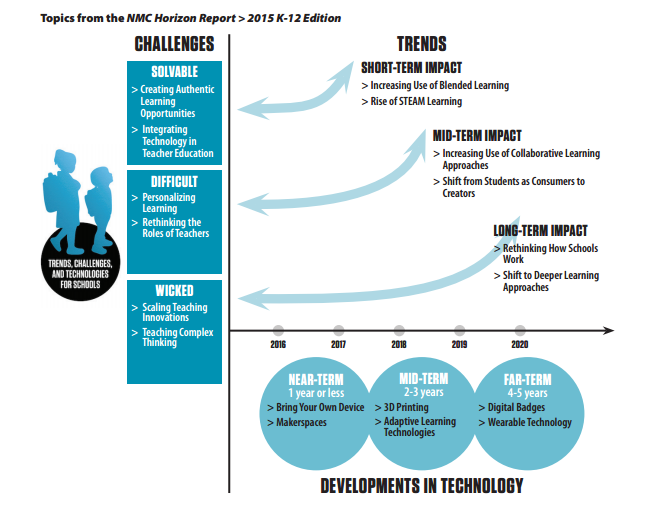Don’t Miss Trends. Short-term. Long-term.
Education is evolving each year. Technology is evolving faster.
Today’s millennials are learning best through interactive technology that has real world applications, encourages learning with their peers, and helps develop critical thinking skills.
As a result of technology’s rapid growth, schools are faced with a great challenge; how do we offer our students the best education possible?
In order to maximize the impact of technology curriculum integration and student learning, schools should be planning in the short, mid, and long-term.
This blog will illustrate the emerging trends showing how technology integration can enhance a school district, with impacts starting in the short-term and continuing into the long-term.
Here are the Top 6 Trends that Schools Can Follow to Integrate Technology into K-12 Education:
Short-Term Impact Trends
Short-Term Impact Trend #1: Increase the Use of Blended Learning
Learning by doing, especially via online resources and digital applications, has become more favorable by school authorities in recent years.
Blended learning, also called hybrid learning, aims to eliminate wasteful in-class time and make the classroom more personalized and friendly for more intimate discussions on the subject matter.
The blended learning model synthesizes online technology with classroom work to build the bridge between what students are learning at home with what they’re learning at school.
Short-Term Impact Trend #2: Embrace STEAM Learning
STEAM, an acronym for “science, technology, engineering, art + mathematics” is a learning method that tries to relate the various disciplines, so that students understand that the courses are inter-related.
In integrating technology into the classroom, schools are uniting class topics and subjects that have not been grouped together before, in a student-friendly orientation.
Mid-Term Impact Trends
Mid-Term Impact Trend #1: Increase the Use of Collaborative Learning Approaches
Collaborative learning, which is essentially students working together in order to learn, is built upon the idea that students learn best with each other, as part of a social activity.
It is best practiced when four criteria are met: students are held in the center of education, interaction occurs regularly, group work is revered, and solutions are created to address real world problems.
Mixing technology into collaborative learning greatly assists students in online learning, and promotes higher level thinking.
Collaborative learning, especially when used with mobile devices, allow students to continually learn from any place, at any time.
Mid-Term Impact Trend #2: Shift from Seeing Students as Consumers to Seeing Them as Creators
By helping students create their subject matter, instead of forcing them to consume content, schools are seeing that their students are deeply engaged with the curricula and are increasingly performing better.
Digital technology is catalyzing the movement, as mobile devices and applications are encouraging students to teach themselves and lead class discussions.
Through empowering students to learn through creativity, schools can trust that their learners will search for deeper meaning, and get more out of class lessons.
Long-Term Impact Trends
Long-Term Impact Trend #1: Rethink How Your School Works
Today’s typical school day is very structured; it begins with a bell and it ends with a bell. Bells are an indicator of one class beginning and another ending.
Additionally, many teachers only teach one or two subjects. As a result, sometimes students put themselves in a “box” and fail to apply concepts that they learned in Mr. Jones’ class to Mrs. Smith’s class.
One way to avoid that is by incorporating digital technology into curriculum, so that students can apply what they are learning in one class to another, and develop a greater understanding of concepts that are relevant in all classes.
Technology is a pivotal step in helping students see school as a comprehensive place of learning, rather than envisioning school as a place that offers six or seven classes that aren’t related.
Long-Term Impact Trend #2: Shift to Deeper Learning Approaches
Expected to have an impact lasting well over five years, experts believe that if schools move toward deeper learning approaches, students will be able to develop critical thinking and multidisciplinary collaboration that would prove useful in project-based learning.
Moving away from standardized testing & traditional textbooks, and embracing student-focused education will empower students to master communication and become more interactive in the classroom.
Through applying technology to project-based learning, problem-based learning, and inquiry-based learning, schools can leverage technology to bridge the gap between class content and real world scenarios.
By integrating technology into classroom curriculum, school districts are investing in their future and empowering students to become more engaged in their learning.
Whether in the short-term, mid-term, or long-term, digital tools are encouraging students to learn by doing, work together, and develop critical thinking skills through comprehensive learning.
With the use of mobile devices and online resources, students are becoming content creators and are applying what they’re learning in the classroom to their daily lives.
By embracing these impact trends, schools will do so much more than just simply integrate technology into their curricula; they will create an intimate atmosphere for students to learn at their most optimal level.
* In late 2015, the New Media Consortium published their annual Horizon Report, mapping out a five year plan of those six key trends expected to deeply impact the global education environment, in the short, mid, and long-term. The report contained valuable insight from very diverse experts, including teachers and board members from universities, online classrooms, and high schools all across the world.
